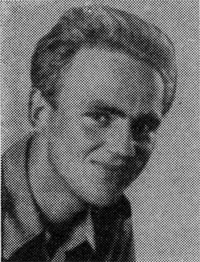Milorg was the main Norwegian resistance movement during World War II. Resistance work included intelligence gathering, sabotage, supply-missions, raids, espionage, transport of goods imported to the country, release of Norwegian prisoners and escort for citizens fleeing the border to neutral Sweden.

Gunnar Fridtjof Thurmann Sønsteby DSO was a member of the Norwegian resistance movement during the German occupation of Norway in World War II. Known by the nickname "Kjakan" and as "Agent No. 24", he was the most highly decorated citizen in Norway, including being the only person to have been awarded the War Cross with three swords, Norway's highest military decoration.
Norwegian Independent Company 1 was a British Special Operations Executive (SOE) group formed in March 1941 originally for the purpose of performing commando raids during the occupation of Norway by Nazi Germany. Organized under the leadership of Captain Martin Linge, it soon became a pool of talent for a variety of special operations in Norway.
Events in the year 1999 in Norway.
Events in the year 1943 in Norway.

Max Manus: Man of War is a 2008 Norwegian biographical war film based on the real events of the life of resistance fighter Max Manus. The story follows Manus from the Winter War against the Soviet Union, through the outbreak of World War II and the occupation of Norway by Nazi Germany until peacetime in 1945. The film is based on Max Manus's own books Det vil helst gå godt and Det blir alvor, as well as other accounts and historical documentation. The film stays largely historically accurate, but omits some events, and moves some of the supporting characters around to show them taking part in events in place of others. The production included around 1,800 extras and 2,000 workers behind the cameras.
Johannes Sigfred Andersen was a Norwegian resistance fighter during the Second World War, a member of the Norwegian Independent Company 1 (NOR.I.C.1). He was nicknamed "Gulosten"; 'The Yellow Cheese'. He also used the surname Ostein during the war. Andersen was a controversial character, because of his pre-war life as a well-known career criminal and a series of incidents that occurred during the war years. These incidents included Andersen working as an assassin during the war, and shortly after the war killing two German prisoners of war during a drinking binge. After the war, Andersen started a wood furniture business. He was supported financially by King Haakon VII of Norway, whose friendship he had gained during the war. Andersen was repeatedly accused of crimes after the war, and on one occasion convicted.

Gregers Winther Wulfsberg Gram was a Norwegian resistance fighter and saboteur. A corporal and later second lieutenant in the Norwegian Independent Company 1 during the Second World War, he was killed in 1944.
Events in the year 1915 in Norway.
Events in the year 1913 in Norway.
Sigurd Bernhard Sverdrup was a Norwegian World War II resistance member.
RMO was a Norwegian clandestine organization for naval intelligence during World War II, led from Oslo. The organization operated from Spring 1942 until the end of the war in the spring of 1945.
Roy Nielsen was a Norwegian resistance member during World War II, a member of Milorg and involved in propaganda and sabotage. Among his sabotage operations was the destruction of 25 Messerschmitt fighter aircraft and 150 engines stored in a bus garage in Oslo, on 14 August 1944, together with Max Manus, Gunnar Sønsteby and others. Together with Max Manus he succeeded in sinking the German troop ship SS Donau in the Oslofjord 16 January 1945, by placing magnetic limpet mines with time delay on the ship's side.
Oslogjengen was a sabotage group operating in Oslo from May 1944 to May 1945, during the last year of the occupation of Norway by Nazi Germany. The group had its basis in both the British Special Operations Executive and the Norwegian Milorg, was coordinated by Gunnar Sønsteby, and had around ten members. It was the dominant sabotage group in Oslo between May and September 1944, when they performed a series of successful sabotage operations.

Petter Moen was a Norwegian resistance member later known for his diaries.
Arnfinn Moland is a Norwegian historian.

Johan Edvard Tallaksen MC & Bar was a Norwegian resistance member during World War II, serving as an ensign in the Oslo Gang and Norwegian Independent Company 1.
Paal Frisvold was a Norwegian general, who was head of the Norwegian Army from 1961 to 1966.
Alf Sanengen was a Norwegian resistance member during World War II, chemist and research administrator. He was born in Glemmen. During the occupation of Norway by Nazi Germany, Sanengen was among the central leaders of the civil resistance. He was manager of Sentralinstitutt for industriell forskning (SI) from 1950 to 1975. He was chairman of the board of Borregaard from 1965. He was a member of the gentlemen's skiing club SK Fram since 1970.
Operation Chaffinch was a World War II mission conducted by a branch of the British Special Operations Executive (SOE) called Company Linge, which was a Norwegian group. The operation aimed to make contact with local resistance groups in the Oslo area and to sabotage shipping. The operation succeeded in sinking the merchant vessel Sanev on 19 May 1943.





